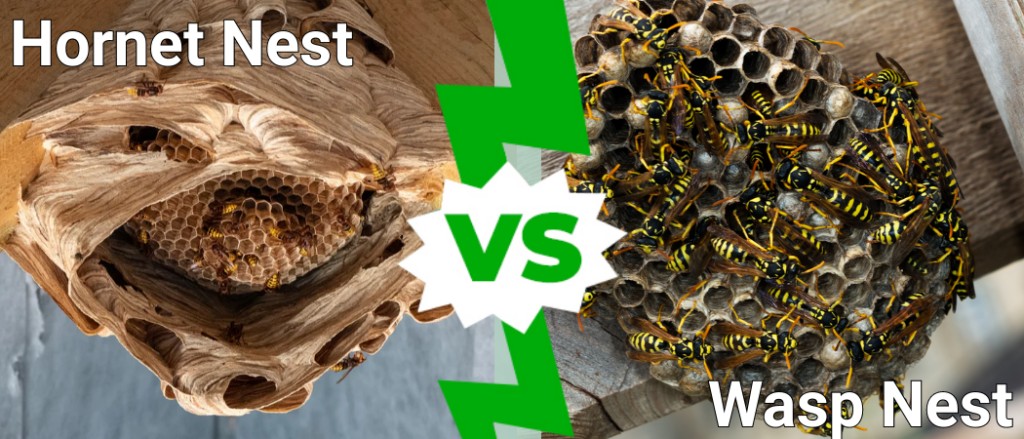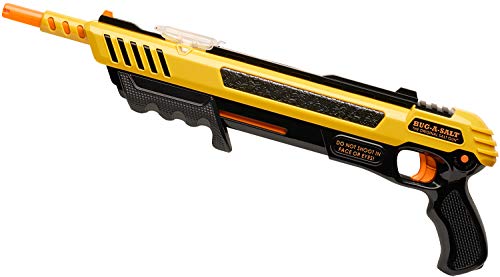Is It A Wasp Or Hornet Nest
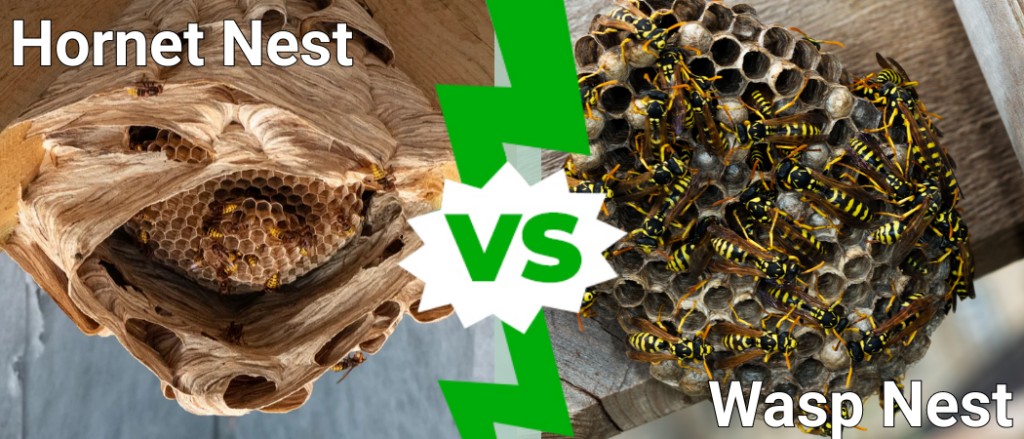
| Hornet’s nest | Paper Wasp’s nest | Mud dauber’s nest | |
| Size | Average size of a basketball, sometimes larger | 6-8 inches, hexagonal design | 2 inches wide, 4-6 inches long, long tubular design |
| Material | Paper-like material made from chewed wood fibers and saliva | Paper-like material made from chewed wood fibers and saliva | Mud or clay mixed with spit |
| Colony size | 100-700 workers plus a queen | 20-30 insects | 1 wasp per nest |
| Typical location | Tree branches, eaves, shrubs | Eaves, branches, pipes, or any sheltered area | Eaves, covered areas, porches |
There is a bit of confusion around the terminology for hornets, wasps, and all the other stinging bugs that live in our yards. To quickly clear things up, the word “wasp” is the general scientific category for all of the stinging bugs we think of when we call something a hornet or a wasp. Mud daubers, yellow jackets, all species of hornets, paper wasps, and more, all belong in the wasp category. Since “wasps” is a broad term, we went ahead and listed three of the most common wasps that are found in the United States: hornets, paper wasps, and mud daubers.
The biggest differences between hornets nests, paper wasp nests, and mud dauber nests are physical size and shape, material, and colony size. Hornets have the largest nest out of the three, often with nests as large as a basketball. Paper wasps are hexagonal “umbrellas” that are usually only a few inches wide. Mud daubers live in a 3-4 inches long tube.
Materially, hornets and paper wasps are very similar, with the mud dauber being the outlier. Hornets and paper wasps chew wood fibers and mix them with their saliva, making a papery building material. Mud daubers, as their name implies, use clay and mud.
Finally, the other major difference is the colony size within the nest. Paper wasps and hornets are social and live in large colonies, while mud daubers are solitary wasps.
Let’s get into the details below!
Hornet Nest Vs Wasp Nest: Size
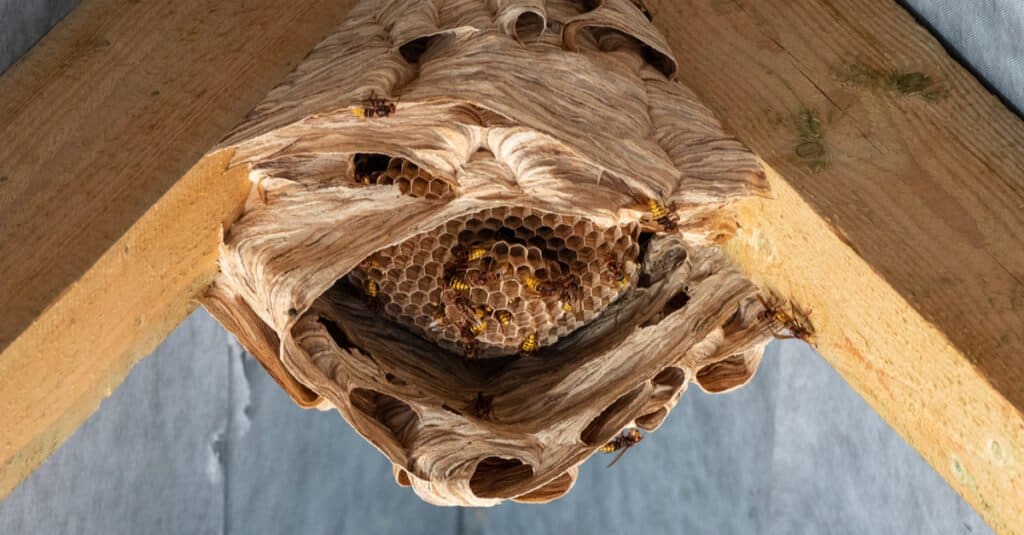
Without a doubt, hornets have the largest nest on our list. When you see a hornet’s nest, you are usually pretty certain what you are looking at. They start off small, but once they are fully built, they average the size of a basketball, although they can get much bigger. These large nests have a single opening and are filled with chambers and tubes, all with different purposes.
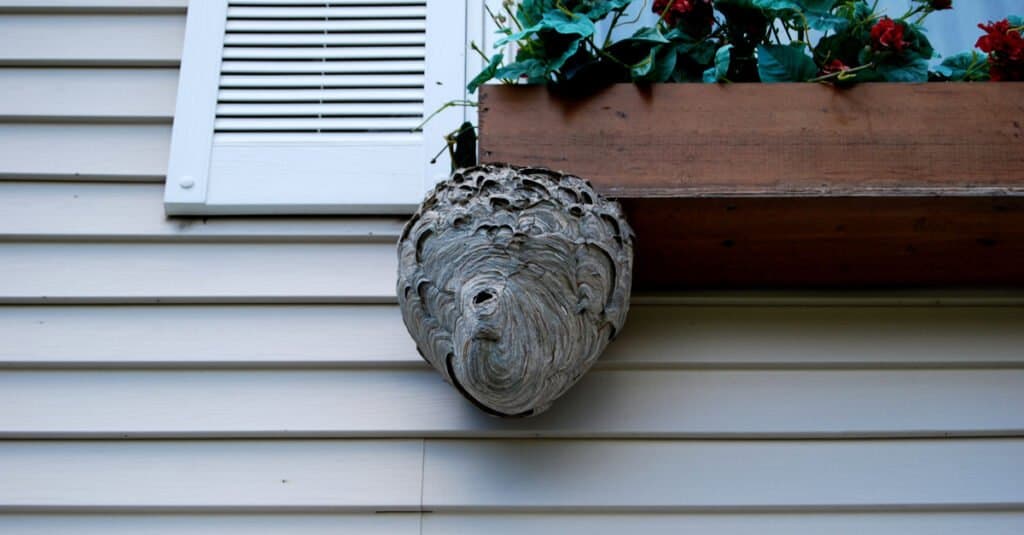
Paper wasps are likely the most common wasps humans are likely to see. Their nests are umbrella-shaped, as if an umbrella without a handle was floating in the air. They are much smaller than a hornet’s nest, usually measuring 3-4 inches in diameter. The underside of the umbrella is filled with hexagonal entrances that wasps come in and out of.

Mud daubers have the smallest nests of the three. They build small tubes, usually only 2 inches wide and 4-6 inches long. They will occasionally add to them, but they are still smaller, mostly because they are solitary wasps.
Hornet Nest Vs Wasp Nest: Material
Material is a great way to distinguish certain wasp nests from one another. A hornet’s nest appears papery, mostly because it actually is. Hornets chew wood fibers into a pulp and then add their saliva to it. This mud is their primary building material and is essentially a form of paper. Layered together, however, it can be strong and durable in most weather conditions.
Paper wasps do something similar to hornets. They also chew wood pulp and mix it with their own saliva to create a building material. Instead of layering it into huge balls as hornets do, however, they turn it into hexagonal columns and passages with an overall smaller form factor.
Mud daubers are unique in their nest building. As their name would imply, they find dirt and clay, mix it with their saliva, and plaster it onto surfaces. Like human constructions involving mud, these structures are rather durable and can withstand a lot of environmental conditions.
Hornet Nest Vs Wasp Nest: Colony size

Colony size and capacity is another important factor that distinguishes certain nests from one another. Hornets have the largest nests of the three and subsequently have the largest colonies. On average, a hornet’s nest can house as many as 100-700 hornets, with some having even more. All the more reason not to poke the hornet’s nest!
Paper wasps have smaller nests and smaller colonies. On average, a paper wasp will have between 20-30 individuals, mostly determined by the weather and their ability to build. In the winter, most of them die out and the cycle restarts. In some places, however, a wasp nest can become truly massive if left alone.
Mud daubers are unlike the other two in that they are known as “solitary” wasps. Solitary wasps don’t have associated colonies and are known for their hunting ability and paralytic venom. Mud daubers almost exclusively eat spiders and will paralyze them with a sting, lay an egg inside of them, and then seal them in a mud tube to grow their young.
Hornet Nest Vs Wasp Nest: Location
Hornets generally prefer large branches of trees that can support the weight of their nests. If a suitable tree isn’t available, they are ok with anything that has covering and room underneath for growth.
Paper wasps are less choosy than hornets. Their only real stipulation is that the location is semi-covered. As a result, humans often find their nests on their eaves, under porches, and in other places they really don’t want them.
Mud daubers have similar preferences to paper wasps in that they like covered areas. You can find them under bridges and in outdoor gazeboes, but they will live pretty much anywhere there is dirt and a place to eat spiders.
Is It A Wasp Or Hornet Nest
Wasp and hornets are both social insects that build nests. They look similar to each other, but they are not the same species. Both wasps and hornets can sting, and they both have a painful bite.
To tell them apart, look at the nest. Wasps build paper nests or mud nests that are open on the bottom. Hornets build paper nests with no openings in the bottom or mud nests with a hole in the bottom for egg laying. Hornets also have one queen per nest, while wasps have many queens per nest.
List Of Is It A Wasp Or Hornet Nest
- Kills wasps, yellow jackets, mud daubers and hornets
- Entrapping foam stops wasps instantly
- Jet spray reaches nests up to 20 feet above ground allowing you to stand a safe distance from the nest
- Kills insects that return to the nest
- Pinpoint accurate foam reaches nests under roof eaves, around carports, doorways, window frames and other outdoor areas
Additional Info :
| Item Dimensions | |
| Height | 2.6 Inches |
| Width | 9.8 Inches |
| Length | 2.6 Inches |
| Weight | 1.2 Pounds |
- Updated with a new, rapid fire Cross Bolt Safety.
- Improved engineering on trigger mechanism. It’s now VERY light – so be careful! Keep away from children and pets.
- Barrel has been lifted & patridge sight added for extremely accurate shooting.
- Improved, more durable salt hopper makes tactical reloads easy during the heat of battle.
- Includes 90-Day Warranty, Limited 1-Year Warranty with Proof of Purchase from Skell. Non-toxic, accurate within 3 feet & no batteries needed.
Additional Info :
| Color | Yellow |
| Item Dimensions | |
| Weight | 2.2 Pounds |
- Product Type :Lab Supply
- Package Dimensions :11.0″ L X8.5″ W X12.0″ H
- Country Of Origin :United States
- Package Weight :18.4Lbs
Additional Info :
| Item Dimensions | |
| Height | 11 Inches |
| Width | 2.63 Inches |
| Length | 2.63 Inches |
| Weight | 1.09 Pounds |
DECYOOL 2 Pack Wasp Nest Decoy Wasp Deterrent for Hornets Yellow Jackets Outdoor Waterproof Material
- Design Principle: Wasp nest decoy could deterrent wasps by simulating the look of an enemy hive in size, shape, and color, several species of wasps and hornets will not build nest near another colony.
- Waterproof material: Made with super light polyester to repel rain and resist wind, way more durable and resilient than paper fake wasp nest. Built for outdoor use in tough environments.
- Safe: Just simply hang the fake wasp nest.
- Size: 2 Pack of durable artificial wasp nests, each hanging eco-friendly wasp deterrent measures 8.5 inches in diameter with a height of 11 inches.
- Easy to hang: You can hang the wasp nest anywhere you want clear of wasps.If you received the item came without the inner wires to make it expand.please contact us in time.
Additional Info :
| Color | Dark color |
| Item Dimensions | |
| Height | 0.5905511805 Inches |
| Width | 8.661417314 Inches |
| Length | 11.023622036 Inches |
